 | ||
| Discover New Zealand, Home of Middle Earth | ||
 | ||
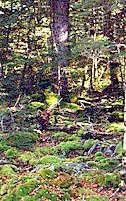 | There are many tales told of Fangorn Forest in Gondor and elsewhere, and the forest itself holds many secrets. But one secret the forest does not keep, and that is that it is incredibly old! It is all very dim and stuffy, with weeping, trailing beards and whiskers of lichen and trees that seem to be half covered with ragged dry leaves that have never fallen! It is an untidy place, where spring never seems to come, and the sunlight itself is tinged with green. Yet it is not all dark and black, simply dim and quiet and very "tree-ish." It is, in fact, the homeland of trees and the ents who tend them, untroubled by birds or animals or any creatures who make any sound except for the sighing of the wind. | 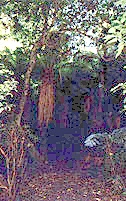 |
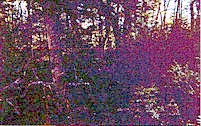 | The trees of Fangorn seem to like their privacy, and stand off from each other, with few youngsters among them. Bushes abound, and make progress through the forest in a straight line difficult. Yet the trees themselves do not bar the way. There is, in fact, a road of sorts along the stony banks of the Entwash, running straight and true from east to west. No doubt Merry and Pippin traveled this way after entering the forest to escape the orcs. | 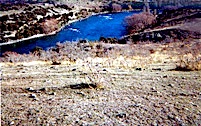 |
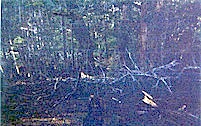 | The first impression of the forest of being shabby and grey changes as one's eyes adjust to the light to one of natural, woody beauty. The trees gleam with rich browns, almost like polished leather, and in the sunlight the boles of the trees have a soft green glow. Through this quiet vastness the Entwash flows slowly and serenely, as if unwilling to disturb the stillness of the forest and the resting of the trees. It is peaceful here, free of the cares of the outside world. | 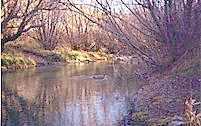 |
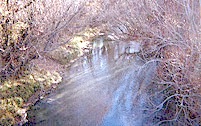 | The Entwash flows from this spring at Wellinghall at the western edge of Fangorn for about 85 miles before emerging on the eastern side. It is at the foot of the Misty Mountains, and from the grasslands just outside, one can see in the distance the peaks of Methedras. Treebeard said that he had brought the hobbits 70,000 entstrides,. This makes one entstride about 6.5 feet. Sam's cousin Hal said he had seen an ent with a 21 foot stride, but he was exaggerating. |  |
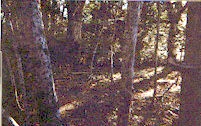 | This is the only place in Fangorn that we could find that might have been Derndingle, the scene of the Entmoot. It is about 11 miles, about 9000 entstrides, south of the Entwash, There is a worn path here that runs downward to a little glade, but there are too many trees to tell if it is bowl shaped or not, and there is no grass. From here there is a kind of fold in the ground that runs southwest toward Nan Curunir, the source of the Isen. | 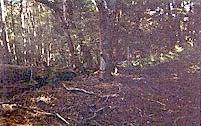 |
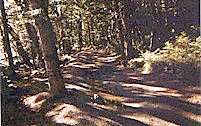 | From the Derndingle toward Nan Curunir there is an opening or path that may have been a road at one time but is now simply an open space in the forest. The ents were certainly used to moving through and among the trees, so the open country did not make them much faster than usual. The distance to the edge of the forest is about 36 miles, and the ents made it in a little over three hours, about the same speed that Treebeard made along the Entwash. |  |
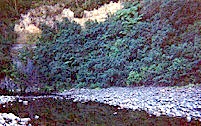 | The Isen arises from a spring at the foot of a ridge over a great cleft at the foot of Mount Methedras, the southernmost of the Misty Mountains. Here is Nan Curunir, the Wizard's Vale, that opens out southward into the plain that is the northern edge of the Gap of Rohan. The Isen is a shallow stream here, trickling and babbling over a stony bed as it hurries steeply downward through the cleft of Nan Curunir to Isengard on its way to the sea. | 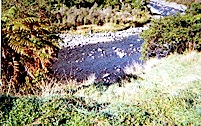 |
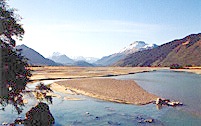 | It was easy to find the location of Isengard, but the tower of Orthanc is gone, and there is no trace of the stone wall or any of the dark chambers or factories that once surrounded it. The entire vale is covered with thick, sticky, silty mud, as if the very sea itself had risen in wrath and fallen on the hills to cleanse them of the evil wrought by Saruman and his minions. The road to Isengard still runs south to the Fords of Isen, some twenty miles away. | 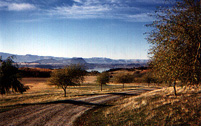 |
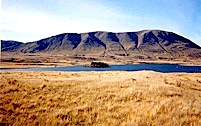 | The photo on the left shows the Gap of Rohan, with Dol Baran, a hill that marks the southern end of the Misty Mountains, in the distance. It is rounded and covered with heather. This area was much traveled in the old days. Except for the hazardous mountain passes and the seacoast, it is the only way from Dunland in the west into Rohan. Freed from its confinement in the Nan Curunir, the Isen flows languidly toward the west, forming a broad area, easy to cross. | 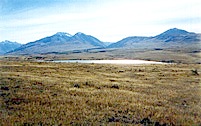 |
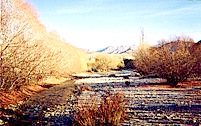 | The Fords of Isen, plural, are so named because the area is not a single ford, but a vast plain across the Gap of Rohan, about ten miles wide. Here the Isen moves slowly and peacefully in its rocky bed. It can be crossed virtually anywhere along this length, a good watering and resting area for travelers from Tharbad in the west. The area shown on the right is the site of a famous battle between King Helm Hammerhand and the armies of Wulf of Dunland. | 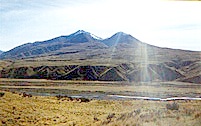 |
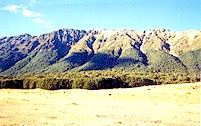 | After crossing the Fords of Isen, the road from Isengard runs southeast toward the Deeping Coomb, the Hornburg, and the fortress of Helm's Deep. The Deeping Coomb is heavily wooded, but the road from the Fords crosses open ground for about twelve miles before it plunges into the woods at the foot of Mount Thrihyrne, which marks the southern edge of the Gap of Rohan and the beginning of the White Mountains, Rohan's southern boundary. | 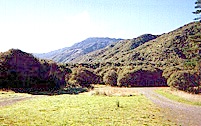 |
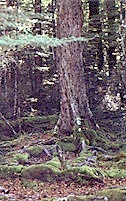 | The woods of the Deeping Coomb is are just north of the plain formed by the circle of rock that ends in the east in a heel sticking out from the northern cliff at the mouth of a steep ravine, the Hornberg. The road from the fords of Isen, such as it is, goes through the Coomb, and makes a pleasant journey out of the hot sun of the open plains of Rohan. Doubtless this is why the road was built in the first place, for it is possible to reach the Fords of Isen by going around the Coomb on the west side, in the area defended by Helm's Deep. It is not possible to get around the Coomb on the eastern edge, because the Deeping Stream, which runs through the Coomb, forms a natural barrier. | 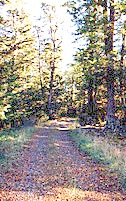 |
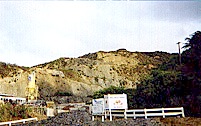 | The fortress of Helm's deep is gone, but the natural rocky formations where it was built still remain. There is a quarry here now, and we were unable to get past the gate to find out what happened to the Caves of Aglarond. We didn't encounter any Rohirrim, but Stefanie did find this horse wandering around. Although it had no bridle, it looked healthy and sleek and obviously well cared for. Could it be related to the famous horses of Rohan? | 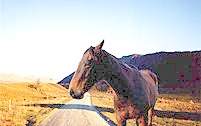 |
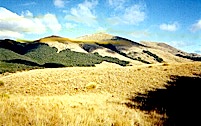 | The Deeping stream flows out of the Hornburg, where the quarry is, so we skirted around and above it and so came to the site of the Battle of Helm's Deep. The open area on the right may be where the Uruk-Hai and orc armies were, and the hills in the left of the photo appear to be the ones where Gandalf and Erkenbrand led their cavalry charge against the forces of Saruman and saved Helm's Deep from annihilation. This looked like a good place to camp for the night. | 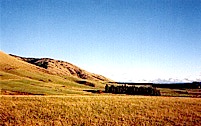 |
Click here to go to Day 11 * Click here to send us e-mail | ||